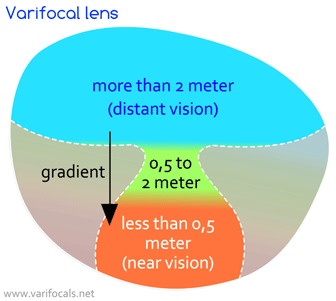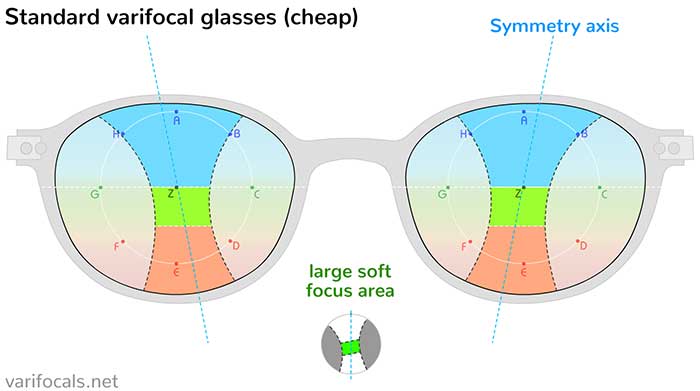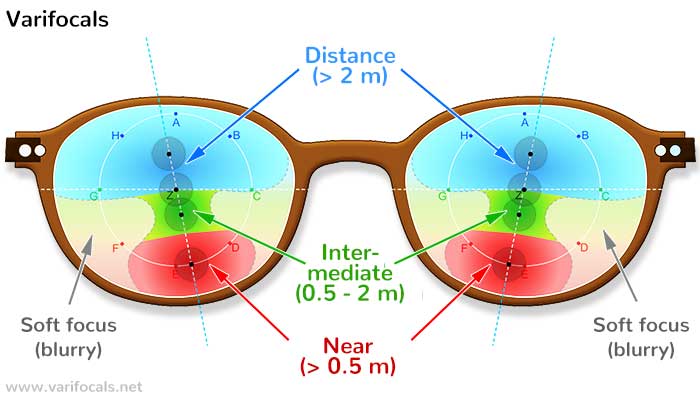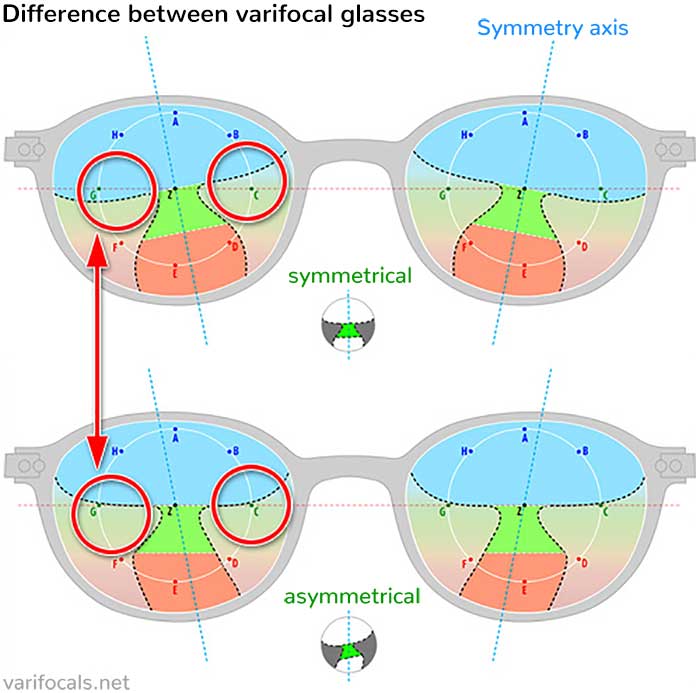Simple varifocals with symetrical glasses

Varifocal lens
The simple - and thus inexpensive progressive lenses - have only a simple, narrow progression zone. The main disadvantage of the simple lenses is that the sharp-imaging zone is severely limited on the left and right.
This is true for all zones (near vision, distance vision and especially the intermediate distances). As soon as you look a little out of the corners of your eyes, the image becomes blurred or out of focus.
The very affordable progressive lenses (under 300 dollar), which are sometimes promoted as special offers by large online opticians or optical chains, usually come with basic lenses. During the consultation, customers are often advised that there are better progressive lenses available, especially when they are customized for specific focal point uses.

but the soft area on the sides are large
Different types of varifocals
The special feature of varifocals is the smooth transition between distance vision and near vision. The area for the intermediate distances is called the progression zone. This transition area of the progressive lens is of decisive importance for the quality of progressive spectacles. In the meantime, some lens manufacturers have started to develop special lens designs for different areas of use. Here, the position and size of the individual zones define the suitable form of use of the glasses.
How large is the progression zone?
The progression zone can be of different sizes. It is bounded at the top by the distance vision, and at the bottom by the near vision (zone). On the sides there are transition zones, which are mainly important for the optics of the lens. In these peripheral areas, no really sharp vision is possible. For this reason, varifocals also allow only limited vision out of the corners of the eye.
Characteristics of the Progressive Lens
A progressive lens is a type of multifocal glasses. The special feature lies in the unique lenses, which correct not only refractive visual impairments at one distance but multiple distances simultaneously. The "refractive visual impairments" include commonly occurring vision problems:
- Nearsightedness
- Farsightedness
- Presbyopia
- Astigmatism
A progressive lens becomes relevant when nearsightedness (often congenital) is accompanied by age-related presbyopia. In such cases, distance vision is not clear (due to nearsightedness), and near vision also becomes increasingly challenging (due to presbyopia). The progressive lens can correct both issues thanks to its unique lens design.

Top: Distance vision (over 2 meters);
Middle: Intermediate distances (0.5 to 2 meters), e.g., computer screen;
Bottom: Near vision (less than 0.5 meters), e.g., reading a book;
the lateral zones on the left and right are smoothly curved and often lead to a slightly blurry image
Lens design becomes better and better
The progressive lens manufacturers (e.g. Zeiss, Rodenstock, Essilor) are researching new "lens designs" that differ primarily in terms of the size / extent of the progression zone. As a result, different types of progressive lenses are now available on the market. Please click for more information:
- Simple standard varifocals (symmetrical axis, cheap)
- Varifocals with asymmetrical axis (better lens design)
- Panoramic varifocals for car driving
- Workspace varifocals - middle distance
- Digital varifocals for smartphones, tablets etc.

